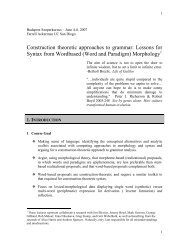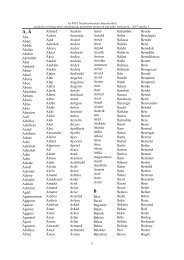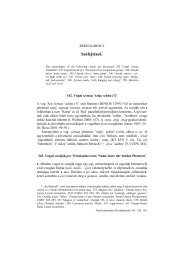Nyelvtudományi közlemények 91. kötet (1990)
Nyelvtudományi közlemények 91. kötet (1990)
Nyelvtudományi közlemények 91. kötet (1990)
Erfolgreiche ePaper selbst erstellen
Machen Sie aus Ihren PDF Publikationen ein blätterbares Flipbook mit unserer einzigartigen Google optimierten e-Paper Software.
THE SONORITY HIERARCHY IN HUNGARIAN 143<br />
Since the counterarguments based on distribution and speech errors are<br />
equally valid in the case of Hungarian, I will not adopt Selkirk's solution<br />
here. But as these cases (e.g. Danish fisk 'fish' vs. fiks 'fix') constitute the<br />
only serious counterexample to (1) and (3) in a number of languages, Selkirk<br />
is obviously right in trying to explain them by some special principle that<br />
leaves the larger generalization intact.<br />
The sum up what we have so far, the mirror image of the onset structure<br />
of Hungarian syllables is, by and large, properly included in the set<br />
of attested coda combinations that make up the coda structure. As Algeo<br />
(1978) notes, it is possible to make the system look a great deal more elegant<br />
by being more selective with the data we include. For instance, the<br />
exclusion of inflected forms would go a long way in eliminating the "irregular"<br />
entries that appear under the diagonal. The 2nd.sg.imp.indef suffix j is<br />
the only source of codas such as döfj 'pierce!', lopj 'steal!', bukj 'fall!', szívj<br />
'suck', dobd 'throw!', or vágj 'cut!', and the 2nd.sg.imp.def suffix d is the<br />
only source of codas such as dobd 'throw!', szívd 'suck!', or tanítsd 'teach!'.<br />
Of the remaining 10 entries under the diagonal, two (NOSZF and<br />
MAFC) could be excluded on the basis that they are acronyms (these were<br />
the only acronyms included in the corpus, because the "spelling pronunciations"<br />
*enóeszef and *emaefcé are never heard) and two (Ape and Szakcs)<br />
because they are proper names. One (borscs 'kind of soup') is the single<br />
example of its type, and another one (szomj 'thirst') can be argued to end<br />
in |h| rather than |j| on the surface. But no matter how hard one tries, there<br />
seems to be no way to exclude füst 'smoke', szaft 'gravy', recept 'prescription'<br />
or akt 'nude'.<br />
As the 'hard' counterexamples all end in i, one might try to reshuffle<br />
the matrix in (6) so that only "easy" items appear under the diagonal. To<br />
see what is involved here, let us take a look at the high end of the hierarchy.<br />
The ordering m


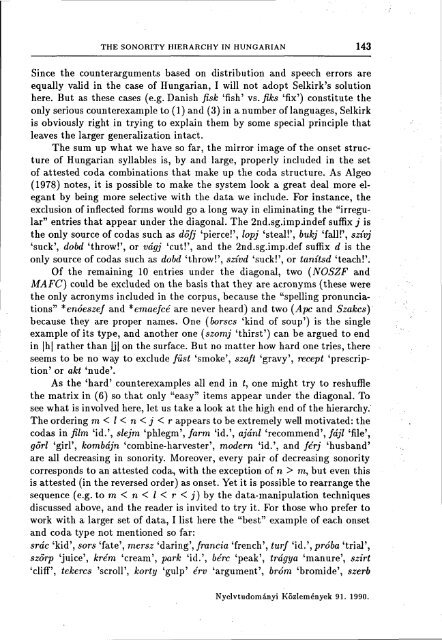

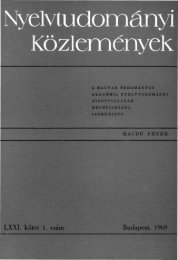

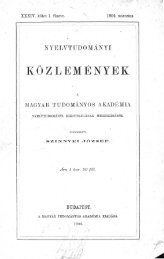
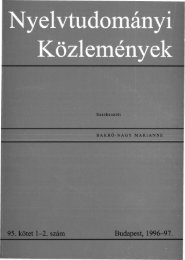
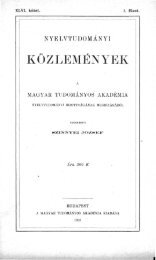
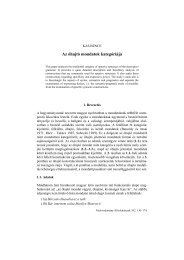
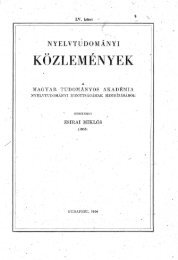
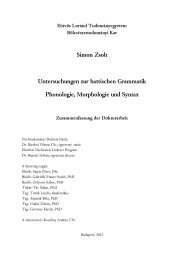
![Gósy Mária: A [p, t, k] mássalhangzók zöngekezdési ideje Bevezetés ...](https://img.yumpu.com/15682849/1/190x245/gosy-maria-a-p-t-k-massalhangzok-zongekezdesi-ideje-bevezetes-.jpg?quality=85)

